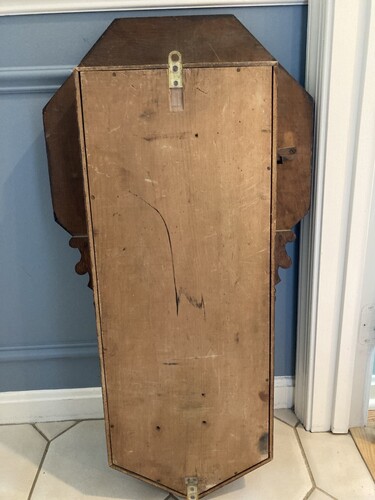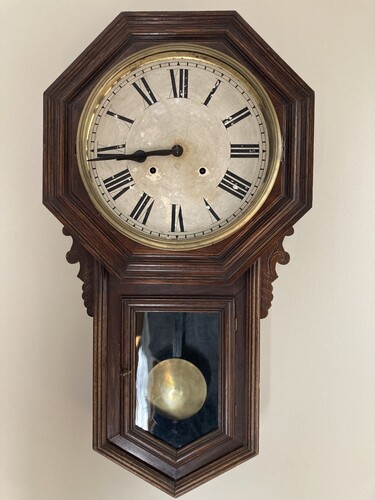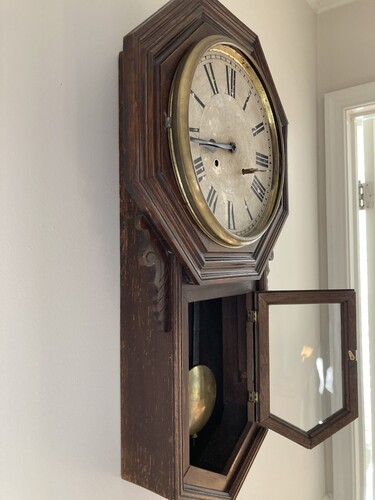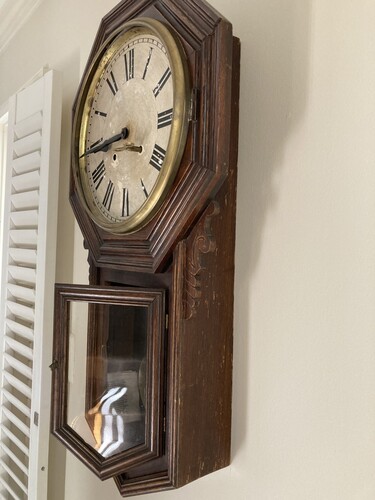Irish 8-day wall clock with New York works - has a brass pendulum and a narrow brass rim around the clock face - walnut case - chimes hourly - glass is missing. Currently not working, but worked for many many years.
Purchased in 1986 in London, England


Hello Gayle,
Thank you for sending in this wall clock to mearto.com for an appraisal. I shall try to help you with that today.
TITLE:
Walnut stained oak, two train, spring driven, eight-day time and hour and half hourly striking, octagonal wall clock with long drop-box, 'Regulator B' model, made by the Ansonia Clock Company of Brooklyn, New York City, USA circa 1901.
DESCRIPTION:
Case: Approximately 30 inches in height, this is a walnut stained oak cased wall clock with a multiple stepped octagonal framed dial surround enclosing a glazed brass bezel. At the juncture of the octagonal head and the long glazed pentagonal drop box below there are two carved and incised foliate side arms attached to the case. The drop has a triple stepped concentrically shaped frame around a glass which allows one to see the arc of the pendulum and bob as it swings inside the case. The backboard is made of white pine and has a simple steel hanger at the top. (This is one of the versions of the American school clock since they were often used in public places and in almost all schools. Some has a long drop, others a short drop, and made by all of the large Connecticut clock companies. Ansonia did start out life in Ansonia Connecticut but moved to NYC after a fire burned down their factory.)
Dial: 12-inch diameter white dial with black Roman hours, closed minute track, steel Spade hands and the dial carrying the Ansonia Clock Company logo under the dial center with the company name and location printed at the base of the dial.
Movement: Not seen but should be a skeletonized brass plate movement with anchor recoil escapement, fly wheel, and powered by two steel springs for eight days and striking a coiled gong on the hour and half hour. The movement plates are most likely cast with the name and location of Ansonia in NYC.
CONDITION:
Case – Signs of wear to the dark stained on the surface with the light oak exposed in several places.
Dial- Spotty wear to the surface of the dial with patchy darkening of the “paper’ surface from exposure to dust in the air.
Movement – Not seen, but assumed original, genuine and functional.
HISTORY:
ANSONIA CLOCK COMPANY HISTORY:
The Ansonia Clock Company’s roots lie in the Ansonia Brass Company, founded by Anson Greene Phelps in 1844. Phelps supplied brass to Connecticut clock manufacturers until 1851, when he joined forces with two powerful clockmakers, Theodore Terry and Franklin C. Andrews, to create a clockmaking company of his own. Terry and Andrews, who had a successful clockmaking business in Bristol, sold half of their business to Phelps in exchange for cheaper brass materials. Thus, the Ansonia Clock Company subsidiary was born.
Many Ansonia clocks are eight-day movements, meaning that they only need to be rewound every eight days. However, in 1875, the company developed a 30-hour, spring-driven illuminated alarm clock with a walnut veneer case. The alarm triggered a match to ignite a wick, which illuminated the clock. Ansonia’s extensive line of clocks included mantel clocks with elaborately painted china cases, beehive shelf clocks, miniature ogee shelf clocks with alarms, shelf clocks with glass domes surrounding the clock’s head, and regulator clocks like the 1886 "General" model, a brass 8-day, weight-driven clock with a cherry case and a dial that counted the seconds. Ansonia was also well-known for its novelty items, such as swinging clocks that featured sculpted figurines. In July 1853, Ansonia showcased its cast-iron clocks, painted and decorated with mother-of-pearl, at the New York World’s Fair. It was one of three Connecticut clockmaking companies to exhibit at the Fair. In the 1870s, the Ansonia Clock Company separated from the Ansonia Brass Company and moved part of its production to New York. Although the company continued to produce clocks in Connecticut, the New York factory, with clockmaker Henry J. Davies at the helm, employed more than twice as many workers—the majority of clocks produced from approximately 1880 on are marked "New York." The Ansonia Clock Company experienced disaster in 1880 when its New York factory caught fire, causing $750,000 in damages. However, the factory was rebuilt at the same location and reopened the following year. In 1883, the Connecticut factory closed, and by the late 1880s, Ansonia had opened sales offices in New York, London, and Chicago. Production peaked 1914, when Ansonia was turning out 440 different models of clocks, but by 1920, that number had dropped to less than 140, and by 1927, it was under 50. In 1929, Ansonia was sold to Amtorg Trading Corporation, the Soviet Union’s U.S. trading company, but in 1969, the rights to the Ansonia name and trademarks were acquired by Ansonia Clock Co., Inc. of Lynnwood, Washington.
COMPARABLES:
This clock, at the height of the market in 1999 sold for $550 at auction. Prices have declined since.
https://www.liveauctioneers.com/item/60360210_ansonia-long-drop-octagon (sold for $120 in 2018)
https://www.liveauctioneers.com/item/56762367_ansonia-long-drop (sold for $70 in 2017)
https://www.liveauctioneers.com/item/58368964_ansonia-mahogany-drop-octagon-8-day-wall-clock (time only sold for $125 in 2017)
https://www.liveauctioneers.com/item/17275960_ansonia-oak-octagon-wall-regulator-clock (sold for $220 in 2013)
PRICING:
Despite the signs of wear this is a charming non-restored wall clock from the heyday of such mechanical clocks, seen in every school across the country.
The fair market value of this piece in perfect condition today would be in the $200 range, and in this unrestored slightly worn condition it would have a fair market value in the range of $125-$150.
Thank you for choosing mearto.com for this appraisal.
My best,
David
Please log in to your Mearto account to contact this seller or make an offer on this item.



